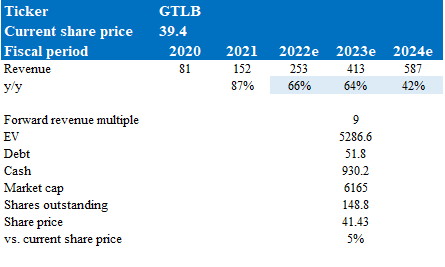Olemedia
Investment thesis
Digital transformation amongst organizations and enterprises is an upcoming trend, with companies increasing their budget allocations for digital transformation. These companies seek a platform that offers a seamless experience between teams and delivers high-quality, secure software.
Gitlab (NASDAQ:GTLB) is a company that offers a DevOps Platform that offers the creation of high-quality software by numerous team members in a cycle that prevents any friction while at the same time guaranteeing the security of the whole process. GTLB has proven to have a great competitive advantage over its competitors by having a single application that comprises all the stages of software development. This system is highly scalable, and existing users act as evangelists to market this product within their companies. Investing in GTLB is therefore a good investment, as it taps into a trend that is on the rise and has guaranteed revenue.
However, my model suggests that GTLB is fairly valued today, and investors should look to invest when valuation gets cheaper.
Business overview
GTLB is a company that offers a DevOps platform that allows development, operations, IT, security, and business teams to design, secure, and develop software in a single application. This represents a step change in how organizations plan, build, secure, and deliver software.
The DevOps lifecycle is changing
Globally, non-digital companies are predicted to increase budget allocations for digital transformation. This is fueled by the need to
- Deliver engaging digital experience to customers,
- Build digital-first products on top of new business models, and
- Rearrange their internal technologies and processes to foster a culture of innovation.
An integral aspect of the digital transformation is companies’ developing their own software. To develop quality software in a short time, these companies need DevOps.
DevOps is a combination of practices and tools that allow an organization to develop applications faster than with traditional software development processes. It is a combination of development [dev] and IT operations [ops], hence the name “DevOps.” By combining these two processes, teams can collaborate to reduce a software’s development lifecycle while still delivering high-quality software. DevSecOps is a discipline and practice that safeguards the whole DevOps environment, enhancing security while maintaining speed. IDC research indicates a growing number of enterprises globally that are investing in DevOps best practices and software tools to hasten the software development process.
The trend toward companies consolidating their point tools in favor of full platform services is also contributing to the rising demand for DevOps. These businesses favor comprehensive platform services because of their desire to optimize operations. This will alleviate the stress placed on their silos as a result of the use of point tools, reduce the fragmentation caused by point stages, and lessen the need to use numerous tools, each of which contributes to greater fragmentation and necessitates manual integration to patch everything together.
Existing solutions are not fit to address the challenges that businesses face today
Most of the current DevOps products have architectures and codebases designed to address individual or specific parts of the DevOps lifecycle. This means that for an end-to-end workflow to be actualized, an organization has to build and maintain different codebases and integrations across its fragmented tools. This type of design has a number of setbacks for an organization, including:
- It creates hidden costs due to context switching across several handoffs,
- Creates security gaps throughout a DevOps cycle,
- Hardens auditability of the development process,
- Slows down the development cycle and subsequently the time to market the product, and
- Results in a fragile architecture prone to breaking down when changes are introduced at any of the point solutions.
These setbacks force organizations to prioritize either security over cycle time or vice versa.
DIY DevOps requires a number of hand-offs and exchanges between teams across contrasting toolsets, introducing friction, switching costs, and reduced speeds. This leads to hindered innovation, prolonged development cycles, and detrimental impacts on business due to the slow software cycle release times of months or weeks instead of minutes or hours. DIY DevOps further moves the core focus of an organization from building new software and products to spending most of their time managing integrations across their tools. This subpar developer experience can lower team or individual morale, leading to low engagement and turnover and, as a result, repelling top talent.
GTLB purpose-built platform helps businesses transition
Investors ought to note that the DevOps platform is at the center of the digital transformation, which is a board-level imperative. GTLB’s DevOps Platform enables users to realize the benefits of DevOps by helping them accelerate the implementation of digital transformation strategies and the creation of new, high-quality business value. Because of this, GTLB has become a strategic partner by facilitating vital business outcomes for its customers.
The DevOps Platform at GTLB is designed to be used throughout the entire DevOps process. Customers primarily use Create and Verify in GTLB.
- Create: Used by programmers to work together harmoniously on a single code base. Further, it facilitates version control by maintaining a record of the changes made by each programmer.
- Verify: Used to perform automated testing and reporting to guarantee that any code modifications meet predetermined quality standards.
The increased interdependence and adoption of GTLB throughout more stages of the DevOps lifecycle is the result of the high levels of developer engagement it permits and the fact that it serves as a system of record for code. To put it another way, this gives GTLB a leg up on the competition.
Ease of deployment
GTLB gives its customers the option to use any hybrid or multi-cloud environment of their choosing by facilitating the management and security of the entire DevOps workflow across all clouds. Additionally, GTLB enables its customers to optimize the best features based on where they will host their DevOps projects by maintaining full feature parity and providing a single application experience across clouds. GTLB makes it possible for clients to use a multi-cloud strategy by helping them avoid vendor lock-in and over-reliance on a single cloud provider.
GTLB benefits from their deployment flexibility, where they can target varied customers. The ease of adoption of its platforms also allows it to target small, mid-range, and the world’s largest enterprises. With the world’s largest enterprises, for example, the initial sale could take place with a smaller team and scale wall to wall across the organization. GTLB’s go-to-market strategy ranges from self-service tiers to high-velocity inside sales to dedicated enterprise sales. Another flexibility is in deployment, where GTLB’s platform can be deployed in the customer’s own cloud environment or in GTLB’s public cloud. Collectively, all these flexibility aspects provide GTLB with a competitive advantage by targeting a broader addressable market of companies, verticals, and users.
Natural path to converting users to customers
GTLB improves the familiarity and affinity of their platform by providing users with a free tier with the goal of encouraging adoption, soliciting contributions, and increasing awareness of the platform. This serves as a highly efficient and targeted source to convert prospects into paying customers. This provides GTLB with a base of users who can act as evangelists for their platform within companies, making it easier for them to expand their existing customer base or secure new paying customers.
Valuation
My model suggests that GTLB is fairly valued today. My model values GTLB on a forward revenue basis, as the business is not generating meaningful profits today. The model follows management’s FY22 guidance, which I believe is achievable given GTLB’s continuous growth momentum thus far.
GTLB is trading at 9x forward sales today, and I assumed it would trade at a similar range 1 year from now as I do not expect any major events that would change this. That said, GTLB used to trade at a much higher multiple, so that leaves room for a potential valuation re-rating upwards.
Based on these assumptions, I believe GTLB’s stock is worth $41.43 in FY23.
Own estimates
Risks
Users may be satisfied with free version of GTLB
The success and growth of GTLB depends on its abilities to convert free users to paying customers by selling them additional products, and upselling additional subscribing services. The rate at which GTLB’s customers purchase additional products and services depend on a number of factors and if the efforts to make them buy are not successful, then GTLB’s business will suffer.
Reliance on open-source technology
GTLB’S development process depends on a number of open source software programs not within their direct control. If the owners of these programs fail to develop or enhance their technologies, GTLB will have to source for other providers or incur another cost on resources to develop and enhance their products. GTLB must also support their own resource contributors by availing adequate resources to avoid relying on third party sources of technologies.
Conclusion
To conclude, I believe GTLB is fairly valued today. That said, I like the business. GTLB proves its platform to be different from its competitors by allowing teams to engage and develop software solutions as a unit. DevSecOps enhances the security of the whole DevOps cycle and the resultant product and service, boosting their perceived value to end-users. With digital transformation taking shape, the use of DevOps by organizations is bound to increase, and GTLB has proven to be an authority with numerous competitive advantages over its competitors.


Be the first to comment